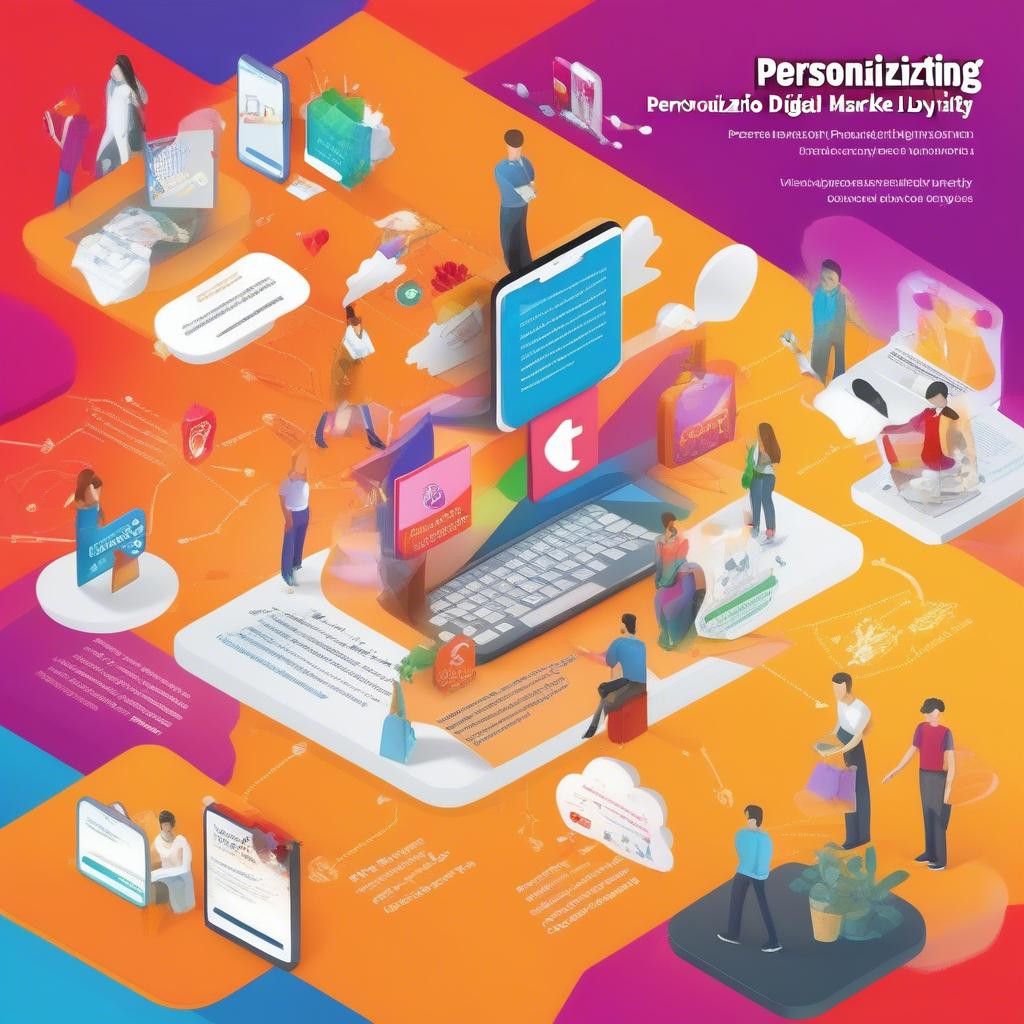Personalization in Digital Marketing: The Key to Customer Loyalty

Personalization in Digital Marketing: The Key to Customer Loyalty
In today’s fiercely competitive digital landscape, generic marketing messages are easily ignored. Customers are bombarded with advertisements daily, making it difficult for businesses to stand out. This is where personalization in marketing comes into play, offering a powerful strategy to cut through the noise and foster lasting customer loyalty.
For a full-service creative agency, understanding and implementing personalization is no longer an option – it’s a necessity. This article will explore how personalization can be leveraged across various digital marketing channels to enhance customer experience strategies, drive engagement, and ultimately, boost your clients’ bottom lines.
The Power of Personalization in Marketing
Personalization goes beyond simply addressing customers by name. It involves understanding their individual needs, preferences, and behaviors to deliver tailored experiences that resonate on a deeper level. It’s about making each customer feel seen, heard, and valued.
Consider this: a generic email blast promoting a new product might yield a low conversion rate. However, a personalized email showcasing products relevant to a customer’s past purchases or browsing history is far more likely to capture their attention and drive a sale.
The benefits of personalization in marketing are numerous:
- Increased Engagement: Tailored content is more likely to capture and hold a customer’s attention.
- Improved Conversion Rates: Relevant offers and messaging lead to higher purchase rates.
- Enhanced Customer Loyalty: Personalized experiences foster a sense of connection and appreciation, leading to repeat business.
- Stronger Brand Perception: Customers perceive personalized brands as more caring and attentive.
- Higher Return on Investment (ROI): By targeting the right customers with the right message, businesses can maximize their marketing spend.
Data-Driven Marketing: The Foundation of Personalization
At the heart of successful personalization lies data-driven marketing. Collecting, analyzing, and interpreting customer data is crucial for understanding individual needs and preferences. This data can come from various sources, including:
- Website Analytics: Tracking user behavior on your website, such as pages visited, products viewed, and time spent on site. Google Analytics is a powerful tool for this purpose.
- Customer Relationship Management (CRM) Systems: Storing customer information, purchase history, and interactions with your business. HubSpot CRM and Salesforce are popular choices.
- Email Marketing Platforms: Gathering data on email opens, clicks, and conversions. Platforms like Mailchimp and Klaviyo provide detailed analytics.
- Social Media Analytics: Monitoring social media engagement, demographics, and interests.
- Surveys and Feedback Forms: Directly asking customers about their preferences and experiences.
- Purchase History: Analyzing past purchases to identify trends and predict future needs.
By consolidating and analyzing this data, businesses can create detailed customer profiles, segment their audience, and tailor their marketing messages accordingly.
Customer Segmentation: Dividing and Conquering
Customer segmentation is the process of dividing your audience into smaller groups based on shared characteristics. This allows you to create more targeted and relevant marketing campaigns for each segment.
Common segmentation criteria include:
- Demographics: Age, gender, location, income, education.
- Psychographics: Values, interests, lifestyle, personality.
- Behavioral: Purchase history, website activity, engagement with marketing campaigns.
- Geographic: Location, climate, population density.
For example, a clothing retailer might segment its audience by age and gender to promote different product lines to different groups. They might also segment based on purchase history to offer loyal customers exclusive discounts.
Effective customer segmentation is essential for delivering personalized experiences that resonate with each group.
Behavioral Targeting: Reaching Customers at the Right Moment
Behavioral targeting involves targeting customers based on their past actions and behaviors. This allows you to deliver highly relevant messages at the most opportune moments.
Examples of behavioral targeting include:
- Retargeting: Showing ads to customers who have previously visited your website but didn’t make a purchase.
- Abandoned Cart Emails: Sending emails to customers who have added items to their online shopping cart but haven’t completed the checkout process.
- Personalized Product Recommendations: Suggesting products based on a customer’s past purchases or browsing history.
- Triggered Emails: Sending automated emails based on specific customer actions, such as signing up for a newsletter or downloading an ebook.
By leveraging behavioral targeting, businesses can increase the likelihood of converting leads into customers and fostering long-term relationships.
Email Marketing Automation: Personalized Communication at Scale
Email marketing automation is a powerful tool for delivering personalized email campaigns at scale. It allows you to create automated workflows that trigger emails based on specific customer actions or events.
With email marketing automation, you can:
- Welcome new subscribers: Send a personalized welcome email series to introduce your brand and offerings.
- Nurture leads: Send targeted emails to nurture leads and guide them through the sales funnel.
- Onboard new customers: Provide helpful information and resources to new customers to ensure a smooth onboarding experience.
- Re-engage inactive customers: Send targeted emails to re-engage customers who haven’t interacted with your brand in a while.
- Celebrate birthdays and anniversaries: Send personalized emails to celebrate special occasions and show your appreciation.
By leveraging email marketing automation, businesses can deliver timely and relevant messages that strengthen customer relationships and drive conversions. Platforms like Klaviyo and HubSpot offer robust automation features.
Hyper-Personalized Ads: Reaching the Right Audience with the Right Message
Hyper-personalized ads take personalization to the next level by delivering highly tailored advertisements based on individual customer data and preferences. This goes beyond basic demographic targeting and delves into granular details such as interests, behaviors, and purchase history.
Examples of hyper-personalized ads include:
- Dynamic Product Ads: Displaying ads that feature products that a customer has previously viewed on your website.
- Personalized Ad Copy: Tailoring ad copy to resonate with specific customer segments based on their interests and pain points.
- Location-Based Ads: Showing ads that promote local businesses or events based on a customer’s current location.
- Ads Based on Weather Conditions: Displaying ads that promote relevant products based on the current weather in a customer’s location.
By leveraging hyper-personalized ads, businesses can significantly improve their ad performance and drive higher conversion rates.
AI-Driven Personalization: The Future of Customer Experience
AI-driven personalization is revolutionizing the way businesses interact with their customers. Artificial intelligence (AI) algorithms can analyze vast amounts of data to identify patterns and predict customer behavior with unprecedented accuracy.
AI can be used to:
- Personalize product recommendations: Suggesting products that a customer is highly likely to purchase based on their past behavior and preferences.
- Optimize website content: Dynamically adjusting website content to match the individual needs and interests of each visitor.
- Personalize email subject lines: Creating email subject lines that are more likely to capture a customer’s attention.
- Predict customer churn: Identifying customers who are at risk of churning and proactively engaging them with personalized offers and incentives.
- Improve customer service: Providing personalized customer service experiences through chatbots and AI-powered virtual assistants.
As AI technology continues to evolve, AI-driven personalization will become increasingly important for businesses looking to deliver exceptional customer experiences. A good resource to learn more about AI in marketing is Marketing AI Institute.
Implementing a Personalization Strategy: A Step-by-Step Guide
Implementing a successful personalization strategy requires careful planning and execution. Here’s a step-by-step guide:
- Define Your Goals: What do you hope to achieve with personalization? Increased sales? Improved customer loyalty? Enhanced brand perception?
- Gather Customer Data: Collect data from various sources, including your website, CRM, email marketing platform, and social media channels.
- Segment Your Audience: Divide your audience into smaller groups based on shared characteristics.
- Develop Personalized Content: Create targeted content that resonates with each segment.
- Choose the Right Tools: Select the right technology to support your personalization efforts, such as email marketing automation platforms, CRM systems, and AI-powered personalization tools.
- Test and Optimize: Continuously test and optimize your personalization efforts to improve performance.
- Monitor Results: Track your results to measure the effectiveness of your personalization strategy.
Conclusion
Personalization in marketing is no longer a luxury – it’s a necessity for businesses looking to thrive in today’s competitive digital landscape. By leveraging data, segmentation, and technology, businesses can deliver tailored experiences that resonate with their customers, foster loyalty, and drive significant results. For a full-service creative agency, mastering personalization is key to providing clients with a competitive edge and helping them build lasting relationships with their customers. By focusing on strategies like customer experience strategies, data-driven marketing, AI-driven personalization, behavioral targeting, email marketing automation, customer segmentation, and hyper-personalized ads, you can unlock the full potential of personalization and achieve remarkable outcomes.
Frequently Asked Questions – FAQ’s
What is personalization in digital marketing?
Personalization in digital marketing is the process of tailoring marketing messages and experiences to individual customers based on their unique needs, preferences, and behaviors. It involves using data and technology to deliver relevant and engaging content that resonates with each customer on a deeper level.
How does data-driven marketing contribute to personalization?
Data-driven marketing is the foundation of personalization. By collecting, analyzing, and interpreting customer data from various sources, businesses can gain valuable insights into individual needs and preferences. This data is then used to create detailed customer profiles, segment the audience, and tailor marketing messages accordingly.
What are some effective customer experience strategies that leverage personalization?
Effective customer experience strategies that leverage personalization include personalized product recommendations, tailored website content, targeted email campaigns, personalized customer service interactions, and hyper-personalized ads. The goal is to create a seamless and engaging experience that makes each customer feel valued and understood.
How can email marketing automation be used to personalize customer communication?
Email marketing automation allows businesses to send personalized email campaigns at scale. By creating automated workflows that trigger emails based on specific customer actions or events, businesses can deliver timely and relevant messages that nurture leads, onboard new customers, re-engage inactive customers, and celebrate special occasions.
What role does AI play in advancing personalization in marketing?
AI plays a crucial role in advancing personalization by analyzing vast amounts of data to identify patterns and predict customer behavior with unprecedented accuracy. AI algorithms can be used to personalize product recommendations, optimize website content, personalize email subject lines, predict customer churn, and improve customer service experiences.
